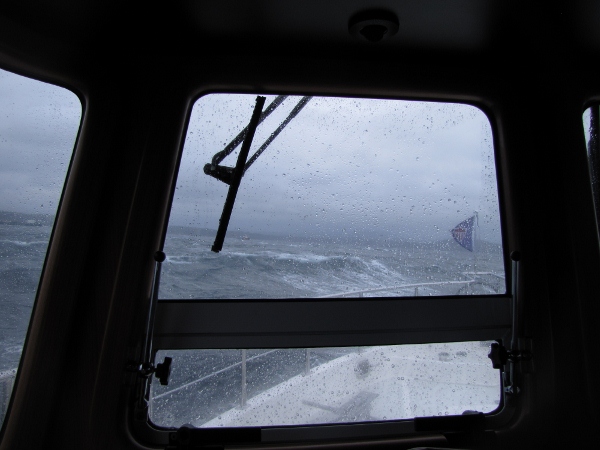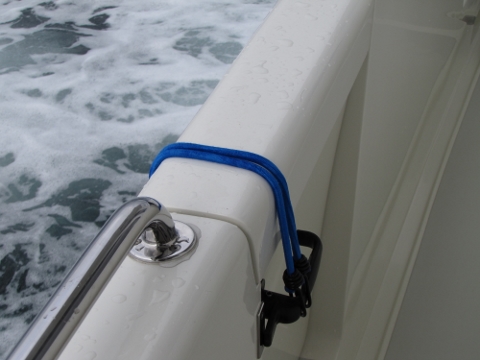.jpg)
We keep our boat ready to sail at all times, with drawers all latched and loose items stowed. When we’re heading out for the weekend, we just need to start the engines and go. Before we lived aboard at Bell Harbor Marina, we could arrive at our Elliott Bay Marina slip on a Friday night after work and cast off the lines in under five minutes. This included the time spent unloading and returning two dock carts. Our next-door slip neighbors, Paul and Pam Lewis on Nordhavn 46 Gryphon, would pretend to time us and jokingly let us know if we were slowing down.
We’ve kept the same practice since moving aboard. We’ll do more preparation, however, when we’re heading out on a run where we might see bigger seas, such as the offshore run to SE Alaska or Prince William Sound.
To prevent a window blow-out should we take a large wave or a knockdown, we cover the five large salon windows with lexan storm plates. The plates screw into welded sockets on the window corners and are easy to install–we can put all five on in less than ten minutes. When not in use, we stow the plates beside the stack on the boat deck, under a canvas cover. On the offshore run to SE Alaska, we didn’t feel the storm plates were necessary. But on the Prince William Sound trip, when waves were breaking against the side of the boat above the level of the pilothouse, we were glad the storm plates were in place.
We also have deadlights, metal covers that screw into the interior of the porthole, for the eight along the sides of the boat (one in the galley, two in the master stateroom, one in the master head, and four in the guest stateroom). Deadlights for the master stateroom are particularly important because the portholes there are large and close to the waterline. A nice side-effect is that the deadlights darken the room, making it easier to sleep there during daylight on a multi-day passage. The deadlights are a little more troublesome to install than the storm plates. The master stateroom deadlights fit right over the top of the porthole, but we have to remove the window hinges to install the rest. We keep them all stowed low in a bilge when not in use.
%20(480x361).jpg)
Our bow roller has a captive pin to secure the anchor underway. Matching the anchor and bow roller holes is a little fussy however, so we use a carabiner and short length of line to secure the anchor most of the time. But when preparing for heavy weather, we use the pin.
.jpg) |
.jpg) |
We’ve installed D-rings in the cockpit and boat deck and use ratchet straps to secure everything on deck. We generally keep them that way, including the heavy outdoor teak tables, although this isn’t really necessary for local conditions. About the only thing we’ll keep loose on a regular basis when underway locally is our teak chairs. But even for a short run across say, the Strait of Juan de Fuca, we secure the chairs as well.
.jpg) |
.jpg) |
We also use ratchet straps and bungee to secure fluids and large bins in the engine room and lazarette, and these always are kept in place.
.jpg)
Other heavy weather preparation items include locking down the davit, and plugging the furnace exhaust so water can’t be forced down. And after the caprail flipped open during the Prince William Sound trip, we now secure it with bungie when preparing for rough seas.
.jpg)
When it comes to managing interior lockers, particularly the galley, one school of thought is to keep the lockers packed as tightly as possible, with no glass containers, so that nothing can shift or break in rough weather. We’d find that a little onerous–we want the galley to be workable in normal conditions. We generally don’t have a problem with items shifting inside galley lockers anyway, even in pretty rough conditions. But when preparing for more extreme weather, we use bubble wrap, nerf balls, and foam scraps to keep thing secure and quiet underway. And we keep a bag of foam scraps handy to stuff into any place that develops a noise–it’s surprising what will move or squeak in big seas. Even with no risk of items falling, keeping noise levels down reduces anxiety–you don’t wonder what is loose and what might happen. Offshore sailors reported that loose items shifting and falling reduces a crew’s confidence in their vessel’s safety.
We put big sheets of bubble wrap above and around our glasses and plates, and wrap any items, such as glass olive oil bottles. And we stuff small pieces of bubble wrap in the fridge and pantry shelves to keep items there from moving.
.jpg)
To keep vertically-stored items such as cookie sheets and baking pans from rattling and shifting, we stuff a nerf ball between them and the locker wall.
.jpg)
We always keep one refrigerator bar in the back half of the fridge–the large heavy bottles there slide too easily. The bars do make taking things in and out a pain, though, so we only put the front bar in place as part of heavy weather preparation.
%20(480x362).jpg)
We have lever latches on anything in the galley that could swing open underway–the fridge, dishwasher and oven doors, the garbage compactor, the freezer drawers, the two large drawers beside the dishwasher, and the heavy sliding pantries. We often use the levers underway locally, and are careful to keep them latched when underway in any rough water. The levers are much easier to use than the standard barrel bolts–we’re glad to have upgraded.
.jpg) |
.jpg) |
To keep any loose items on flat surfaces from shifting, we distribute silicone baking mats throughout the boat and keep a round sheet in the microwave. Rick Lamb of Nordhavn 47 Sojourn Mariner recommended them. The mats look better than the non-skid liner we use in our lockers, and are thin, so items can rest partway on the mat.
.jpg) |
.jpg) |
Our Ekornes chairs have swing tables that we stow, but we leave the chairs loose. We’ve never had a problem with them even shifting until the Prince William Sound return trip–one of the chairs actually flipped over when we took a particularly large wave on the side. If it happens again we might devise a way to secure them, but haven’t felt the need so far.
.jpg)
Hi.
I really liked Your decision to strengthen the Windows.
Tell me please:
1) Тhe Bolts attaching the polycarbonate of what diameter?
2) What is the thickness of polycarbonate?
Thanks
The bolts are 1/4″ and I think the storm plates are 1/2″ thick.
Thank you so much. Have a nice cruise.